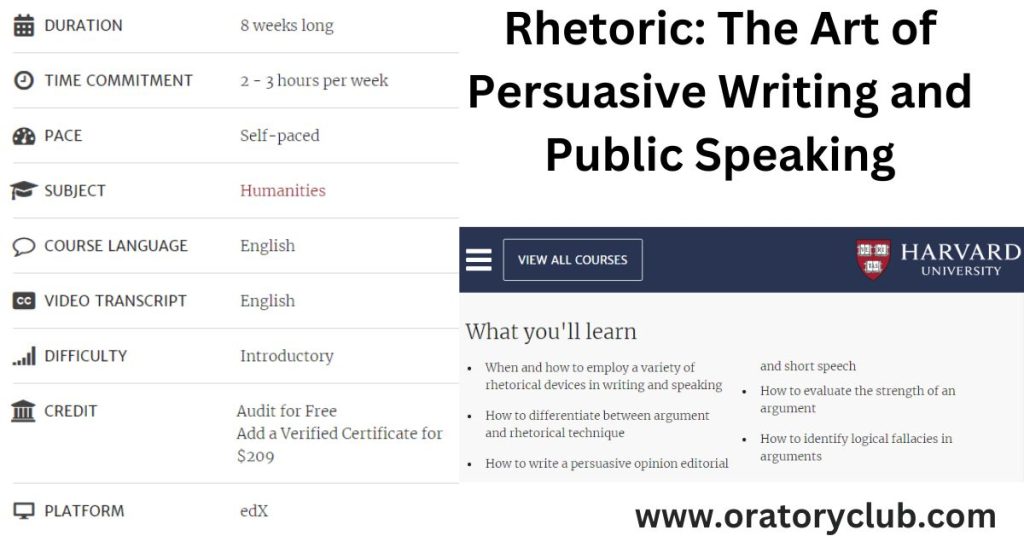Rhetoric: The Art of Persuasive Writing and Public Speaking by Harvard
In a world fueled by ideas and communication, the ability to articulate thoughts persuasively holds immense power. Enter the “Rhetoric: The Art of Persuasive Writing and Public Speaking” course – a transformative journey into the heart of effective communication. Developed by Harvard University, this course, led by the esteemed Professor James Engell, is a comprehensive exploration of rhetoric, unveiling the secrets of crafting compelling arguments and delivering impactful speeches. In this overview and review, we delve into the course’s structure, content, and its potential to empower learners with the art of persuasion.

Course Overview: The “Rhetoric” course is a gateway to mastering the art of persuasive communication. Designed to empower learners in various settings – from academia to the professional world and beyond – this course encompasses both theory and practice. Participants will embark on a journey through various modules, analyzing selected speeches by prominent figures, and honing their skills through writing and speaking exercises. The core concepts covered include rhetorical structure, style analysis, and the techniques used to persuade audiences.
Key Course Elements:
Let’s delve into the seven key course elements in detail, exploring how each element contributes to a comprehensive understanding of persuasive communication.
1. Diverse Speech Analysis: Understanding persuasive communication starts with the analysis of real-world examples. In this course, you’ll dive into speeches by prominent figures, each representing a distinct context, purpose, and style. By dissecting speeches from different eras, you’ll gain insights into how speakers craft their arguments and connect with their audiences.
Practical Application: Analyze Martin Luther King Jr.’s “I Have a Dream” speech. Identify the use of metaphors, vivid imagery, and emotional appeal to understand how he effectively conveyed the urgency of the Civil Rights movement.
2. Exploration of Historical Contexts: Context plays a vital role in shaping persuasive communication. Through the lens of history, you’ll examine speeches related to critical social issues. You’ll witness how rhetorical techniques are tailored to resonate with audiences during times of social change.
Practical Application: Compare speeches from figures like Sarah Brady and Charlton Heston on the topic of gun control. Understand how their rhetoric reflects their stances and resonates with their respective audiences.
3. Understanding Oratory: Oratory, the art of public speaking, is a cornerstone of persuasive communication. By delving into the nuances of oratory, you’ll uncover the techniques that skilled speakers employ to engage, inspire, and persuade their listeners.
Practical Application: Explore techniques such as pacing, intonation, and emphasis. Record and analyze your own speech to identify areas for improvement and incorporate effective oratorical elements.
4. Unpacking the Red Scare: Political rhetoric holds a unique place in persuasive communication. Studying speeches from the era of Joseph McCarthy and Margaret Chase Smith provides a captivating opportunity to understand how political agendas are advanced through rhetoric.
Practical Application: Analyze McCarthy’s tactics of accusation and fear-mongering. Develop your own speech that addresses a current issue using persuasive techniques that are grounded in ethical communication.
5. Presidential Influence: Presidents are some of history’s most skilled communicators. Analyzing speeches by John F. Kennedy and Ronald Reagan will help you appreciate the impact of presidential rhetoric on national consciousness.
Practical Application: Break down Kennedy’s inaugural address to identify the call for unity and shared responsibility. Craft a short speech addressing a contemporary issue while incorporating similar rhetorical strategies.
6. Crafting Persuasive Assignments: Effective learning requires practical application. In this course, you’ll draft Op-Eds and speeches, applying the principles learned in each module. This hands-on approach enables you to actively engage with persuasive techniques and refine your communication skills.
Practical Application: Select a current issue that resonates with you. Draft an Op-Ed expressing your viewpoint and use persuasive devices to make your argument compelling.
7. Interactive Online Learning: Harnessing the power of technology, this course offers video excerpts from Harvard Professor James Engell’s lectures. Engaging with these lectures provides you with insights and perspectives that guide your exploration of persuasive communication.
Practical Application: Take notes as you watch the video lectures. Identify key takeaways, relevant examples, and techniques discussed. Apply these insights when analyzing speeches and crafting your assignments.
Guidelines For Collaboration:
Collaboration is a vital aspect of learning, and the course encourages participants to engage in meaningful interactions while respecting the boundaries of academic integrity.
- Collaborative Approaches: The course encourages participants to work together to develop general approaches to assignments. This fosters a sense of community and enables learners to benefit from diverse perspectives.
- Hints and Assistance: If stuck on an assignment, learners can seek hints or assistance from both peers and course staff. This approach ensures that while learners receive guidance, they still actively engage with the material.
- Independent Problem-Solving: While collaboration is encouraged, learners are responsible for working out the finer details of assignments independently. This ensures a balance between collaborative learning and individual growth.
- Originality and Honor Code: It is emphasized that learners should not copy or replicate someone else’s submission. Upholding the honor code is crucial to maintaining a fair and respectful learning environment.
Practical Application: Engage in thoughtful discussions with peers to develop strategies for tackling assignments. If you encounter challenges, seek hints and guidance to enhance your understanding. Remember to maintain academic integrity by ensuring your work remains authentic and original.
Discussion Forums:
Discussion forums are integral to the learning experience, providing a platform for learners to connect, share insights, and engage with course content.
- Asking Questions: Learners can use the discussion forum to seek clarifications on course content, assignments, or concepts they find challenging.
- Collaboration on Assignments: Discussion boards are suitable for collaborating on assignments, offering an opportunity to bounce ideas off peers and receive feedback.
- Starting Thoughtful Discussions: Initiate discussions related to course content, share opinions, and engage with the instructors and fellow learners. This promotes critical thinking and a deeper understanding of the subject matter.
- Constructive Feedback: The discussion forum allows learners to comment on course content, offering constructive feedback, suggestions, and insights for improvement.
Practical Application: Actively participate in the discussion forum by asking questions, sharing your thoughts on course content, and collaborating with peers on assignments. Remember to maintain a positive and respectful tone while engaging in discussions.
By adhering to the “Guidelines For Collaboration” and effectively utilizing the “Discussion Forums,” learners enhance their overall learning experience within the “Rhetoric: The Art of Persuasive Writing and Public Speaking” course. These elements not only foster collaboration and engagement but also facilitate deeper comprehension of the course material through dynamic interactions with fellow participants.
Grading and Certification:
The course structure ensures active engagement and real-world application. Graded assignments include:
- Op-Ed Final Draft: Learners express their support or opposition to an idea or policy in a 300-600 word article.
- Speech Final Draft: Crafting a speech (5 minutes maximum) that conveys their stance on a particular topic, with peer grading providing comprehensive feedback.
- Speech Feedback Survey: Students present their speech to an audience, collect feedback, and complete a survey based on the feedback.
Course Outline:
With a well-structured layout, learners progress through key modules, ensuring a holistic understanding of persuasive communication:
- Module 1: Introduction to Rhetoric
- Module 2: Civil Rights – Martin Luther King Jr.
- Module 3: Gun Control – Sarah Brady and Charlton Heston
- Module 4: Introduction to Oratory
- Module 5: The Red Scare – Joseph McCarthy and Margaret Chase Smith
- Module 6: Presidential Rhetoric – John F. Kennedy and Ronald Reagan
- Module 7: Conclusion
- Module 8: Full Lectures (Optional)
Certification:
Upon successful completion, learners who have opted for a Verified Certificate can proudly display their achievement, reflecting their mastery of persuasive communication. However, having a certificate costs $209.
Conclusion:
The “Rhetoric: The Art of Persuasive Writing and Public Speaking” course stands as a testament to the power of effective communication. Whether you’re a student, professional, or anyone seeking to enhance their ability to influence, this course offers a transformative learning experience. Guided by the expertise of Professor James Engell, learners unravel the art of persuasion, foster civil discourse, and propel positive change in an ever-evolving world. Through insightful analysis, interactive assignments, and practical skills, this course equips you with the tools to make your voice heard and shape the narrative around you.





